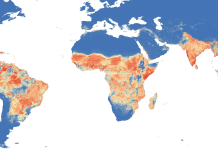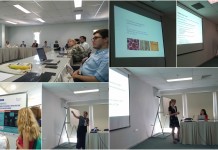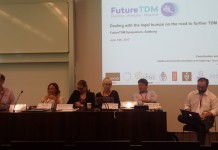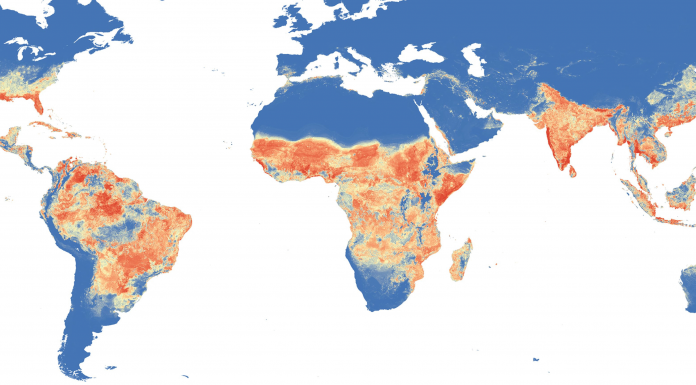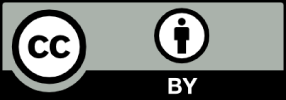In order to foster the exploitation of TDM in European scientific, economic and public sectors, and eventually boost economy and society as a whole, the scope of work within this project will be structured into six main objectives.
INVOLVE all key stakeholders via targeted stakeholder consultation to identify practices, requirements, and specific challenges in the field of TDM and installation of an advisory board and integration of practitioner groups in local and pan-European workshops.
The FutureTDM platform is meant for use not only by developers and researchers, but also a variety of other end-users including publishers, funders, public bodies, research organisations, technology firms, content and data providers and management companies, and many more. As such, the project takes on the ambitious objective of integrating and involving stakeholders from the outset. This continual multi-stakeholder involvement throughout the project gives FutureTDM a unique scope in ensuring that prospective changes to TDM activities in Europe is driven by strategic engagement and empowerment activities. The consortium partners will define relevant stakeholder groups, and collect potential practitioner groups across different TDM influenced sectors. Through the use of comprehensive stakeholder studies and consultations the project will identify potential early adopters of the FutureTDM platform. These early-adopters will assume critical roles in the functionality, calibration and validation of the collaborative and support information platform. Similarly, the planned workshops will provide insight into the existing state of TDM and the barriers that are limiting TDM uptake.
ASSESS existing studies, legal regulations and policies on TDM within the European Union considering generic and domain-specific barriers and national idiosyncrasies/anomalies, and compare them with international developments.
In order to obtain an overview of the current state and all its limiting factors and barriers, this objective aims for a comprehensive assessment of the status quo. A primary objective of the FutureTDM project is to aggregate the pertinent information from such sources into a structured framework for subsequent legal, economical, and technological analysis. Such collections of studies, issues, sources and solutions will serve as the foundational information base of the FutureTDM framework. The project will determine a comprehensive analysis of the existing TDM research and innovation landscape by:
- Desktop-based research of scientific studies, strategies and policies, and uptake of TDM across Europe for the current and future assessment of overcoming existing legal and policy barriers
- Collect and evaluate European and national regulatory frameworks, including policy and legal instruments, jurisprudence, and case law that are relevant for TDM directly or indirectly, including a strength- and weakness analysis while maintaining a perspective on international TDM standards and practices
- Generate a baseline report of existing policies, legal issues and standards that can be shared across the publishing and research communities to subsequently build solutions to enhance TDM uptake
ANALYSE current application areas and trends in TDM including statistics and key figures, collect relevant research and industrial projects, derive best practices and provide a structured collection of relevant knowledge and information resources.
To achieve this objective, case studies, best practice projects, e-tools, applications, and platforms that are currently using TDM will be collected following a specified structure. They will be assessed according to a common evaluation framework, and will feed a comprehensive FutureTDM information platform, that will serve as the comprehensive on-line resource for TDM practitioners and related stakeholders. Furthermore, in this objective an analysis of the current TDM application areas and trending fields, including the underlying legal and technical prerequisites and assumptions will be conducted to provide the community with key up-to-date statistics and insights of various member states to identify areas of improvement in terms of disciplines and geography. As such, in achieving this objective, the FutureTDM project aims for the following:
- Identify application areas where TDM has already proved to be successful in the past as well as potential areas and trends where TDM could prove rather promising in the near future in order to direct and amplify the exploitation in such areas
- Build, in collaboration with the EINFRA-1 winning proposal, an inventory of technical tools, resources, and platforms that are required in order to actually conduct TDM, including a collection of vendors and application areas of focus
- Conduct structured interviews to collect case studies and best practices from past and ongoing initiatives, especially of relevant programmes such as FP7 or H2020, to build a compendium of 10 best practices outlining TDM uptake
ELABORATE a legal and policy framework for future TDM, define policy priorities, specify a research agenda with future applications in mind to create interdisciplinary, case-driven practitioner guidelines to foster the spread of TDM in various research fields within the EU.
This objective will focus on elaborating a policy framework that will address and potentially alleviate the current legal barriers that inhibit TDM practices across Europe. The developed framework will have to address several issues including current intellectual property law, licensing solutions, copyright, and related exceptions, database rights, and personal data protection and privacy issues. Within this objective, practitioners and policy makers will receive a realistic overview about the current state of TDM from a legal perspective taking into account the interests of relevant stakeholders. This critical objective will be achieved by:
- Develop novel policy, legal and organisational framework and guidelines that tackles pertinent issues surrounding current legal issues (including copyright exemption/exception) and takes into consideration the interests of various key stakeholders
- Support and foster the use and adoption of openness inspired policies and legal instruments as well as related technical solutions taking into account existing and emerging operational and business models
- Create practitioner oriented guidelines that cover a dynamic range of disciplines and TDM related topics that are validated through stakeholder feedback mechanisms
- Prepare fundamental policy priorities and research agendas that promote the economic and societal value of TDM to collectively boost uptake in academic and commercial settings
BUILD a web-based platform including intuitive tools like a TDM Stakeholder Map, a TDM Expert Navigator, a European TDM Research Project Directory, or a TDM Best Practices Library.
To be able to coordinate and support TDM opportunities in Europe, FutureTDM has developed a web-based collaboration and open information platform to foster knowledge and information transfer. An objective of the FutureTDM project is to support the open information ecosystem and make acquired content harmonized, curated and freely accessible. Furthermore, the FutureTDM platform is meant to be lasting and evolving, and as such the technical partners of the consortium will ensure a scalable architecture to support growth and expansion. The creation of the FutureTDM platform will be accomplished by:
- This newly launched platform that will aggregate, illustrate, and exploit the research results in a clear and insightful way for all users for practical application • Generate a TDM Stakeholder Map and TDM Expert Navigator modules to allow practitioners and various stakeholders to quickly connect, collaborate and foster exchange to promote TDM opportunities across Europe
- Build a dynamic repository of TDM relevant research projects and TDM best practices, based on research and interviews established in WP4 that will further provide a comprehensive information resource to empower practitioners and stakeholders
INCREASE awareness of TDM to especially attract new target groups and science domains by creating a roadmap, run mobilisation and engagement activities and provide information material and modern TDM Visualisations and Infographics.
As a result of the involvement and knowledge transfer this project will cause, communities of different areas come together and get involved, eventually leading to the ultimate objective of increasing awareness of TDM across various settings and stakeholders (universities, research institutes, European and international organisations, content publishers, commercial users, etc.). The planned mobilisation and engagement activities with a practitioner-led focus of the FutureTDM project will help overcome the barriers and challenges of TDM uptake and strive towards creating a sustainable research and innovation agenda. This objective of promoting TDM activities will be achieved by:
- Raise awareness by driving social media campaigns, promoting the FutureTDM platform and the topic in general as well as involving other communication channels.
- Prepare create and insightful visualisations and infographics throughout the duration of the project that convey important messages about the state of TDM adoption and also pose additional interesting questions
- Arrange the FutureTDM symposium, which will also feature installations of knowledge cafés and stakeholder discussion panels to bring together key actors and practitioners




